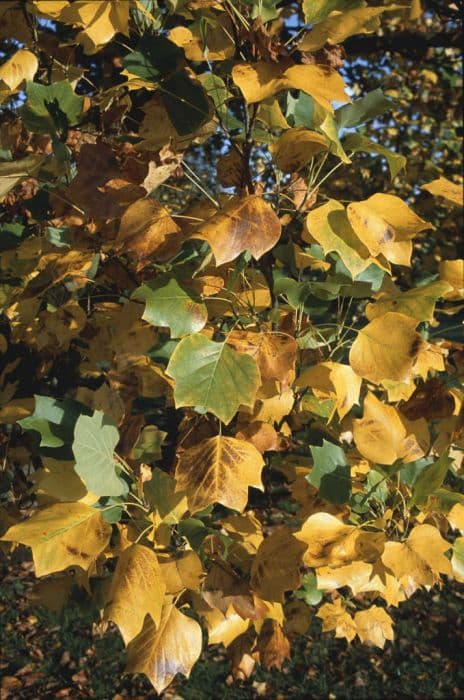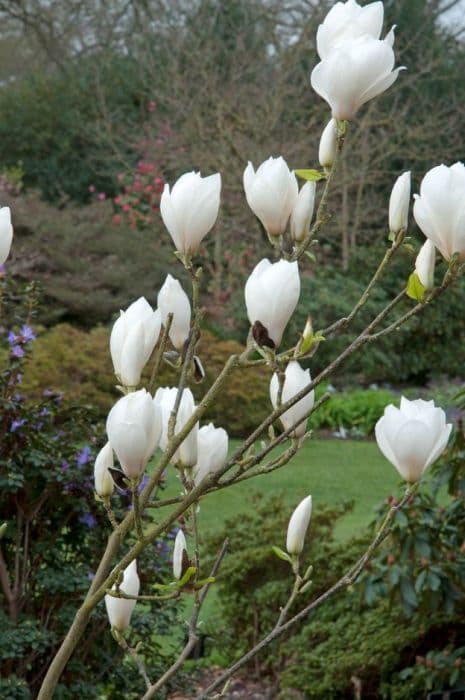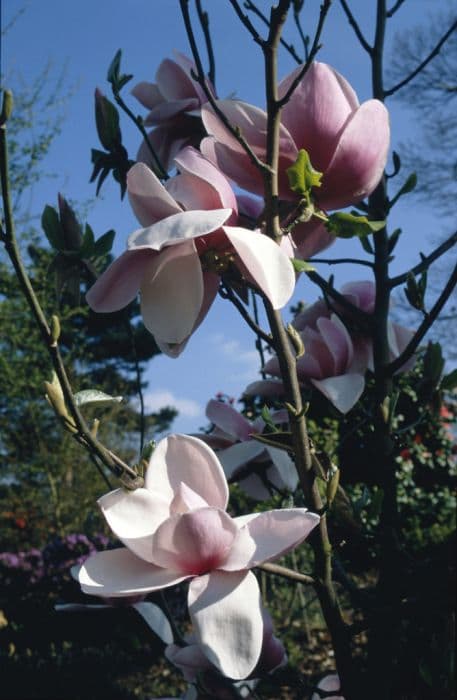Oyama magnolia Magnolia sieboldii 'Colossus'

ABOUT
Magnolia sieboldii 'Colossus', commonly known as the Oyama magnolia, is an ornamental plant with a striking appearance due to its large and showy flowers. These blooms are cup-shaped and feature pristine white petals that gracefully frame a center containing a vibrant burst of pink or red stamens, producing a stark and beautiful contrast. The flowers exude a subtle and pleasing fragrance that can attract pollinators as well as the admiration of onlookers. The foliage of the Oyama magnolia is equally attractive, composed of deep green leaves that are large, leathery, and oval-shaped with a slightly pointed tip, often providing a lush backdrop for the bright blooms. In fall, the leaves may turn a golden yellow color before they shed, adding seasonal interest to the plant's display. As a deciduous shrub, it loses its leaves in the winter, and the bare branches set a stark silhouette against the winter sky. The bark of the Oyama magnolia is typically smooth with a grayish-brown hue that provides a neutral contrast to the other colorful elements of the plant. During the fruiting season, the Oyama magnolia produces cone-like fruits that showcase an array of seeds. When these seeds mature, they present a visible display of red or orange against the fruit's softer background, which might capture the interest of various bird species. Overall, Magnolia sieboldii 'Colossus' is a plant with a captivating presence in the landscape due to its vivid, fragrant flowers, dense green foliage, striking fruit, and smooth bark, creating a multi-seasonal interest for any garden setting.
About this plant
 Names
NamesFamily
Magnoliaceae
Synonyms
Oyama Magnolia, Siebold's Magnolia
Common names
Magnolia sieboldii 'Colossus'.
 Toxicity
ToxicityTo humans
Siebold's magnolia is not commonly known to be toxic to humans. There are no significant reports or evidence of toxicity in humans resulting from contact with or ingestion of Siebold's magnolia. Therefore, there are no specific symptoms of poisoning associated with this plant for humans.
To pets
Siebold's magnolia is not commonly known to be toxic to pets, including dogs and cats. There is no widespread documentation suggesting significant toxicity, and no specific symptoms of poisoning have been consistently reported in pets related to ingestion or contact with Siebold's magnolia.
 Characteristics
CharacteristicsLife cycle
Perennials
Foliage type
Deciduous
Color of leaves
Green
Flower color
White
Height
10-20 feet (3-6 meters)
Spread
6-10 feet (1.8-3 meters)
Plant type
Tree
Hardiness zones
6-8
Native area
East Asia
Benefits
 General Benefits
General Benefits- Ornamental Value: Produces large, fragrant white flowers with a striking maroon center that add beauty to any garden setting.
- Attracts Wildlife: Flowers provide nectar for pollinators such as bees and butterflies.
- Seasonal Interest: Offers year-round interest with its glossy green leaves, showy flowers in late spring and summer, and attractive seed pods in fall.
- Shade Provider: Can be used to create shaded areas in the garden due to its size at maturity.
- Drought Tolerance: Once established, it is fairly tolerant of drought, reducing the need for frequent watering.
- Landscape Versatility: Fits well into a variety of landscape designs, from formal to naturalistic settings.
- Cold Tolerant: Can withstand cold temperatures, making it suitable for many temperate climates.
- Low Maintenance: Requires minimal pruning and care once established, making it a good choice for low-maintenance landscapes.
- Privacy Screen: When planted in groups, it can provide a dense screen offering privacy and wind protection.
- Longevity: Is a long-lived tree, providing lasting value to the landscape.
 Medical Properties
Medical Properties- Anti-inflammatory: Magnolia sieboldii extracts have been reported to have anti-inflammatory properties.
- Antioxidant: The plant contains compounds that exhibit antioxidant effects, helping to neutralize free radicals in the body.
- Anti-cancer: Some studies suggest that certain compounds found in Magnolia sieboldii might have anti-cancer properties.
- Anti-anxiety: The plant has compounds that can have a calming effect, potentially reducing anxiety symptoms.
- Neuroprotective: There is evidence to suggest that extracts from the plant may offer protection to nervous system cells.
- Antimicrobial: Components of Magnolia sieboldii might inhibit the growth of certain bacteria and fungi.
 Air-purifying Qualities
Air-purifying QualitiesThis plant is not specifically known for air purifying qualities.
 Other Uses
Other Uses- Magnolia sieboldii 'Colossus', commonly known as Oyama magnolia, can be used in bonsai. Due to its beautiful flowers and branching structure, enthusiasts may cultivate it in miniature form as a bonsai.
- The bark and wood of Oyama magnolia are sometimes used in small woodworking projects, such as inlays and crafting of small decorative items due to their fine grain and workability.
- With its large, showy flowers, the Oyama magnolia may be used in floral arrangements to add an exotic and elegant touch to bouquets and centerpieces.
- The Oyama magnolia's leaves can serve as a delicate backdrop in pressed flower crafts, where they contribute texture and a rich green color to the artwork.
- Dried seed pods from the Oyama magnolia can be used in decorative wreaths and as part of other dried flower arrangements, adding a natural and unique element to home décor.
- Artists can use the Oyama magnolia's varied forms and colors as inspiring subjects in botanical illustrations and landscape paintings.
- Photographers often seek out the Oyama magnolia as a subject for nature photography, especially when the flowers are in bloom, for its striking appearance.
- In educational settings, the Oyama magnolia can be used as a teaching aid in botany and horticulture courses to demonstrate flower anatomy and pollination strategies.
- The fallen petals of Oyama magnolia can be gathered and used in crafting natural dyes, which provide a soft green or brown color to fabrics.
- In large gardens and parks, the Oyama magnolia can be planted to create a natural privacy screen or windbreak due to its dense foliage.
Interesting Facts
 Feng Shui
Feng ShuiMagnolia is used in Feng Shui practice for promoting purity and nobility, often suggesting essences of feminine and lunar energies. Planting a Magnolia in the garden is thought to encourage harmony and can be placed in areas to enhance the wood element, promoting growth and vitality.
 Zodiac Sign Compitability
Zodiac Sign CompitabilityMagnolia is not used in astrology practice.
 Plant Symbolism
Plant Symbolism- Perseverance: Magnolia sieboldii 'Colossus', commonly known as Oyama magnolia, is known for its resilience and capacity to withstand hard environments, symbolizing the human quality of perseverance in facing challenges.
- Nobility: The magnificence of the Oyama magnolia’s blooms is often associated with a sense of dignity and splendor, making it a symbol of nobility.
- Femininity: The delicate and fragrant flowers of the Oyama magnolia represent purity and femininity in various cultural contexts.
- Peace: In some cultures, the soothing presence of the Oyama magnolia and its tranquil appearance are emblems of peace and tranquility.
- Love of Nature: The Oyama magnolia's preference for wooded environments embodies a deep love and appreciation for nature and the outdoors.
 Water
WaterThe Oyama magnolia needs consistent moisture, so it should be watered thoroughly once a week, providing roughly 1 inch of water each time. In periods of drought or extreme heat, water twice a week instead, ensuring the soil remains moist but not waterlogged. A slowly trickling garden hose or a drip irrigation system can be useful to provide deep watering that reaches the roots. For container-grown Oyama magnolias, check the top inch of soil, and if it feels dry, water until moisture seeps out of the drainage holes. This could mean providing around half a gallon for smaller containers or up to 2 gallons for larger ones each watering session.
 Light
LightThe Oyama magnolia should be placed in a spot where it can receive full sun to partial shade. Ideally, it benefits from morning sunlight and some afternoon shade, particularly in hotter climates. The plant is adaptable but tends to flower best with ample light, so a position that gets 4 to 6 hours of direct sunlight is optimal.
 Temperature
TemperatureThe Oyama magnolia thrives in temperatures that range from 60 to 70 degrees Fahrenheit ideally, but it can tolerate a wider range. It can survive short periods of colder winter temperatures down to about 20 degrees Fahrenheit and can also withstand high summer temperatures up to around 90 degrees Fahrenheit. However, prolonged exposure to extremes outside this range can be stressful for the plant.
 Pruning
PruningPrune the Oyama magnolia to maintain its shape and remove dead or damaged wood, which helps to encourage healthy growth and air circulation. The best time to prune is in late winter or early spring before new growth starts. This tree typically requires light pruning once a year to remove any crossed branches or to shape the tree as desired.
 Cleaning
CleaningAs needed
 Soil
SoilThe Siebold's Magnolia prefers acidic soil with a pH between 5.5 to 6.5, well-draining and rich in organic matter. A good soil mix can include equal parts of loamy soil, peat moss, and perlite or pine bark fines to aid drainage and provide aeration. Mulching helps maintain soil moisture and temperature.
 Repotting
RepottingSiebold's Magnolia doesn't need frequent repotting; it is typically repotted every 2-4 years. Young plants may grow more rapidly and can require repotting every 2 years, while mature, established plants may be repotted less often.
 Humidity & Misting
Humidity & MistingSiebold's Magnolia does well in moderate to high humidity levels, thriving in environments with 50% to 60% humidity. Consistent humidity is beneficial, but the plant is quite adaptable and can tolerate lower humidity levels without significant issues.
 Suitable locations
Suitable locationsIndoor
Provide bright, indirect light and keep soil moist.
Outdoor
Plant in partial shade and shelter from strong winds.
Hardiness zone
6-9 USDA
 Life cycle
Life cycleThe life of the Magnolia sieboldii 'Colossus', commonly known as the Colossus Siebold's Magnolia, begins with seed germination, typically after stratification which simulates winter conditions. After germination, the seedling develops into a juvenile tree, focusing on root growth and the development of a few leaves. As it matures into an adult plant, it exhibits rapid vegetative growth, expanding in height and girth, and begins to develop its characteristic large, fragrant, white flowers with a hint of pink and prominent stamens during the late spring and summer. The adult tree will enter a period of reproductive maturity, where it produces and drops seeds encased in cone-like fruit, completing the cycle of seed dispersal. Throughout its life, the Magnolia sieboldii 'Colossus' undergoes seasonal changes, shedding its leaves in the fall and entering dormancy through the winter months. With proper environmental conditions and care, this magnolia can live for several decades, continuing its cycle of growth, flowering, and seed production.
 Propogation
PropogationPropogation time
Spring-Early Summer
Propogation: The most popular method of propagating the Oyama magnolia is through semi-hardwood cuttings. This typically involves taking cuttings from the current year's growth during the summer months when the wood is semi-ripe - neither too soft nor too hard. After the cuttings are taken, they should be treated with a rooting hormone and then placed in a well-draining propagating mix. The propagation environment should be kept humid, which is often achieved by covering the cuttings with a plastic dome or placing them in a misting chamber. Cuttings can take several weeks to root, and during this time, they should be kept out of direct sunlight to prevent excessive heat buildup and moisture loss. Once rooted, they can be potted up into individual containers and allowed to grow on before being planted out in a more permanent location.









